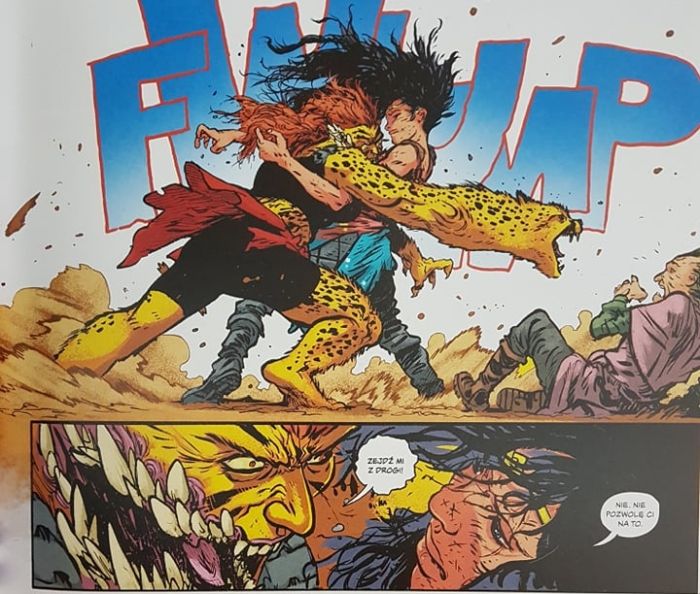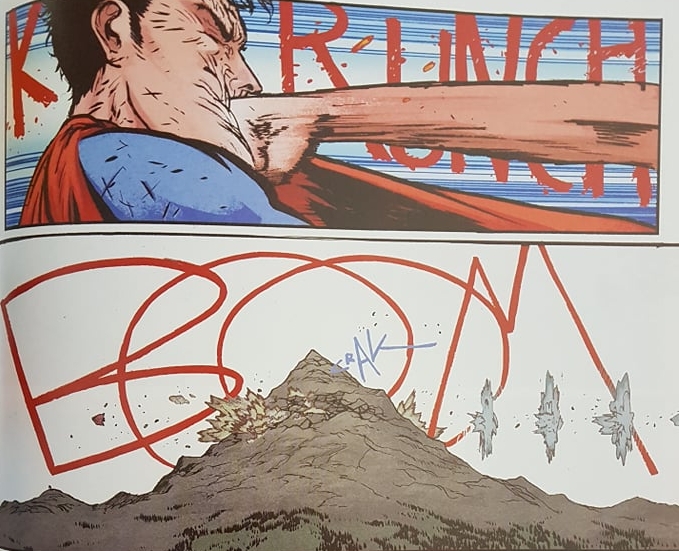Diana, like the heroine of a purebred RPG, wakes up deprived of memory. The world she knew was gone forever. Several hundred years earlier, a tragic event occurred that turned the planet into a nuclear wasteland. The remnants of humanity try to survive at all costs, though the mighty creatures called Hydras seem to have other plans. Wonder Woman, affected not only by amnesia but also by a lack of power, decides to help the survivors and solve the mystery of the Dead Earth.
Marvel vs DC
The Old Man Logan mentioned in the introduction was a kind of comic book of a road in a crooked, post-apocalyptic mirror. Writer Mark Millar, in his typical style, focused on irony and grotesque – hence the scenes were filled with such ideas as T. Rex under the control of a Venom symbiote or a bunch of gigantic, green and feral rednecks , descendants of Hulk. Wonder Woman: Dead Earth is a much more serious title. In its construction, it is very similar to the classic of the genre – Mad Max. The characteristic core of the plot, known from Rockatansky’s adventures, has been carefully recreated here: the protagonist (k) meets a group of people in a deplorable situation on his way, but out of the heart’s need he decides to save them, even at his own expense. And so in the Daniel Warren Johnson comic, Wonder Woman becomes the last hope for survivors, despite the obscure situation in which she finds herself. In this context, “humanizing” Diana works very well. Amnesia is a fairly cheap screenwriting trick, but in this case it serves perfectly for the dramaturgy – with each new notebook, new secrets are revealed in front of the reader (and the protagonist). It also deepens the motivation of Wonder Woman, who, despite her confusion, decides to help humanity here – only because of her love for man.
In most cases, supporting characters do not stand out with anything special – they just fulfill roles typical of the genre. Hence, it is difficult to get attached to them, and their death (quite frequent) is indifferent to the reader. It’s hard to have greater feelings for them like the cartoon Diana, so take her word for it. A guest role in the plot is also played by Cheetah, who was “shattered” here – as a result of pre-war experiments, her cheetah head was sewn in place of her right hand.

Black tag
Originally Wonder Woman: Dead Earth appeared in four issues as part of the DC Black Label. This imprint focuses on stories addressed to a more mature reader, where the authors can afford more freedom in terms of plot, as well as a more serious tone. And all of these elements in Johnson’s comics are clearly visible. At one point, Diana uses the skull and spine as a morgenstern. Stupid? Yes. However, it works great visually! Hydras, on the other hand, are not only disgusting (full of tumors and mutant tissue), but also deadly, making the gore elements scroll every few pages. Fortunately, they are not used by the writer to senselessly dazzle with shocking scenes, but only emphasize the brutality of the presented world. For a decent oneElseworlda befits, Dead Earth can be read with only a cursory knowledge of the DC world. Wonder Woman is the last superhero on the planet, but the reader, thanks to flashbacks, also learns about the sad fate of Superman and Batman (who dies on the bench, finally experiencing a moment of peace …).

Spoiler alert
This paragraph will contain spoilers, so if you are allergic to them, please skip to the next section. While the comic reads well, I have some problems with the clichéd character of some plot solutions. The very cause of the conflict – the great war between humans and the Amazons – was sewn with thick threads. Relations are tightening for ecological reasons (which in itself is timely), but I find it hard to believe that one small island would be able to fight the rest of the world. The use of nuclear weapons by mankind is similarly clichéd, which is another cliché. The real cause of the planet’s destruction also requires the suspension of disbelief. Showing that it is Wonder Woman’s responsibility for the catastrophe is interesting and dramatic, but at the same time the writer makes you believe that that the apocalypse struck the planet as a result of the flames from Diana’s frantic attack on Superman. Sometimes omitting this type of exposure works better (such as inThe living dead where the zombie plague is not solved) than giving imaginary solutions.

Author mainstream
Mainstream artists such as Greg Capullo (from the aforementioned The Last Knight on Earth ) can be found on DC Black Label , but they often feature cartoonists with a more original approach. This is what it is like in Dead Earth, where Johnson shows his full talent. His line, reminiscent of the achievements of Paul Pope (known, among others, from Battling Boy ), is full of dynamism and expression. It’s full of dirt and brutality, which complements the colors of Mike Spicer perfectly. I also liked the new look of Diana – far from the typical image of a model / bodybuilder. In Johnson’s comics, Wonder Woman looks more human: with matted hair and a tired face.

Wonder Woman never changes
Dead Earth is a good title, efficiently using the freedom to be a story outside the main canon. The main character has to face both the threats of the present world and the traumas of the past. This comic sparkles when he plays with DC iconography and superhero themes. It is worse when he focuses too much on copying the classics of the genre, which makes the post-apocalyptic threads fall into a cliché. However, I hope DC Black Label will provide more items at this level.

